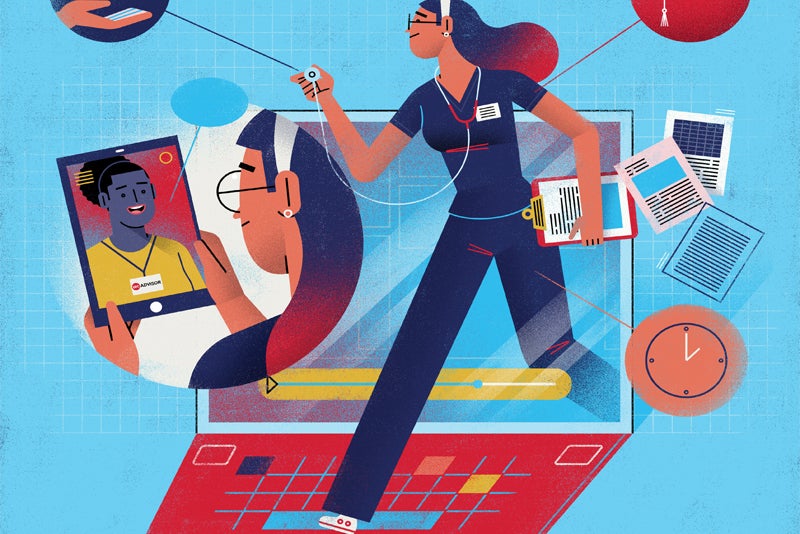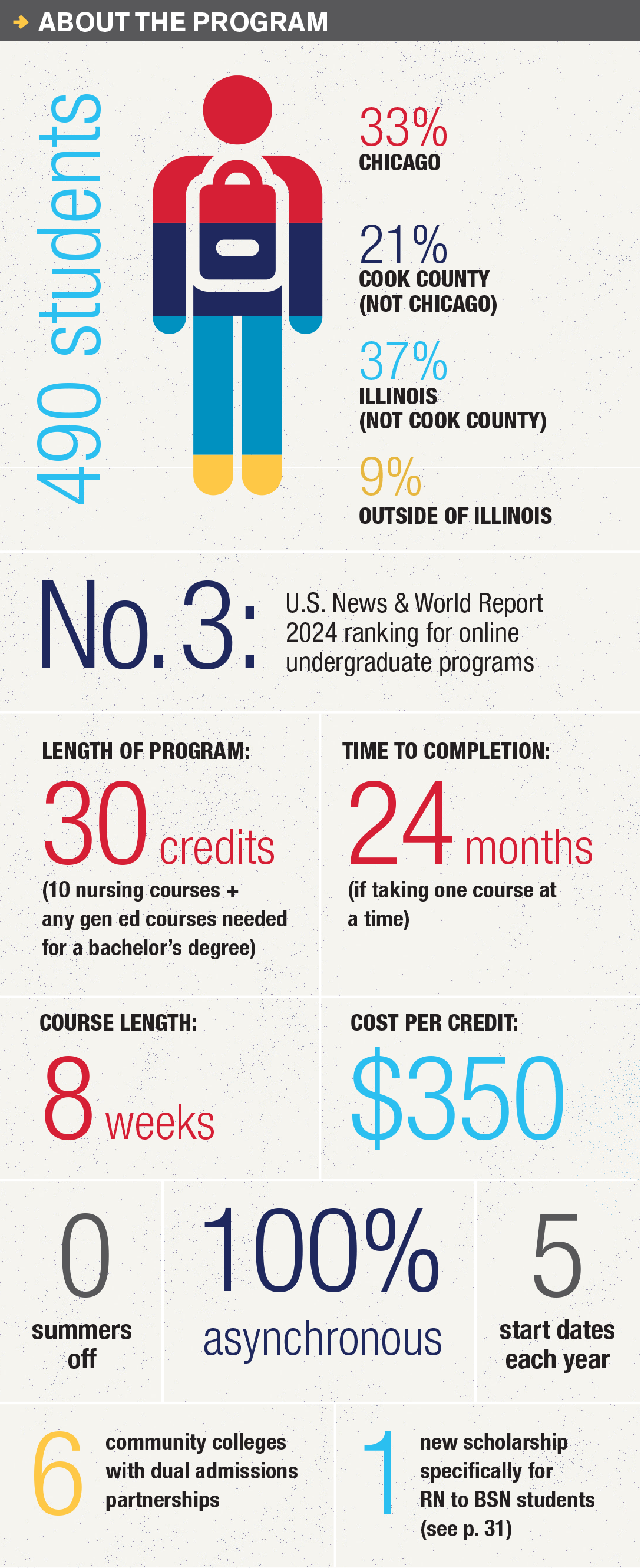Full of remote possibilities
UIC Nursing's highly lauded online RN to BSN Completion Program, ranked No. 3 among online programs by U.S. News & World Report in 2024, has seen exponential growth in recent years.
body copy

They tend to be older than the typical bachelor’s degree student. They’re already
working as nurses. Often while juggling full-time jobs, kids, mortgages, car payments and other responsibilities, a growing number of students are flocking to UIC Nursing to get their bachelor’s degrees through the college’s RN to BSN program.
In the last few years, the program’s size has increased significantly. It is now the
largest in the college with around 500 students. Because it is entirely online and no clinical placements are required, the program’s capacity far exceeds that of a traditional brick-and-mortar BSN program.
However, those factors also make the program, which is jointly administered by UIC Extended Campus, less visible to the UIC Nursing community.
“We’ve got this hidden jewel at UIC,” says Kate Tredway, MS ’97, RN, MBA, one of two co-directors of the program. “It consistently ranks in the top 5 in the nation. It is one of our largest—and still fastest-growing—degrees. It’s perfectly designed for its audience of professional nurses. It does online education right.”
There are 706 RN to BSN programs available nationwide, including more than 630 programs that are offered at least partially online, according to the American Association of Colleges of Nursing (AACN). In this packed marketplace, what
sets UIC Nursing’s RN to BSN program apart is access to UIC Nursing’s faculty experts, online courses tailor-made by professional instructional designers, ample student support from advisors and instructors, and an emphasis on practical application that ensures authenticity for working professionals.
“We wrap our arms around students,” says the program’s other co-director Gloria E. Barrera, RN, PEL-CSN. “Having that support is key for a successful online program.”
Rosa Malave, BSN ’16, who is now enrolled in UIC’s DNP program, says she felt “really supported” in the RN to BSN program, even before she started, by advisors who helped her navigate credits and tuition. Malave worked full-time as an emergency room nurse and then as an interventional radiology nurse during
the program.
“I’m an older student, and I was nervous about the online portion,” says Malave, now 43. “I didn’t grow up doing online courses. At UIC, there were always exemplars and instructors available to help. They emphasized that nurses need to elevate the profession to improve quality care. I felt very strongly about that.”
Humble beginnings

Humble beginnings
UIC Nursing’s RN to BSN program started in-person on the Quad Cities campus in 1980 with only a handful of students. As distance technology expanded, so did the program. By 2008, the program was offered fully online, and UIC Nursing began partnering with what is now called UIC Extended Campus to provide the infrastructure for an online degree.
Since 2020, the program has grown from about 200 students to its fall 2024 enrollment of 490.
College and program leaders made several changes to help grow the program. These include allowing students to fulfill prerequisites after admission to the program and reducing the tuition rate to $350 per credit.
“UIC’s degree is a great value,” Barrera says. “It’s high-quality and a relatively low price.”
They also forged six dual admissions partnerships with community colleges across the state of Illinois. These customized agreements allow students to enroll in a community college program to earn their associate degree in nursing while simultaneously enrolling in courses from UIC Nursing’s RN to BSN program, ensuring a seamless transition to a bachelor’s degree.
Current partnerships are with Malcolm X College, College of Lake County, Waubonsee Community College, Lewis and Clark Community College, Blackhawk College and Carl Sandburg College.
Why it matters
Nurses with higher levels of education significantly improve patient outcomes, according to AACN. Having higher rates of BSN-prepared nurses in hospitals is associated with greater odds of surviving cardiac arrest, lower odds of inpatient mortality, lower odds of death in patients with Alzheimer’s and related dementias, and a decrease in the length of hospital stays.
“Having that BSN, having the education, helps practicing nurses adapt to changes in health care delivery,” Barrera says. “Ultimately, earning a BSN also enhances professional recognition and job security, making individuals more competitive in the job market.”
Many hospitals, and some states, require nurses to obtain a bachelor’s degree within a certain number of years of working. Nurses in New York, for instance, must earn a bachelor’s degree within 10 years of licensure, a law intended to address the increasing complexity of the American health care system.
Why it works
The program was created with the help of professional instructional designers, and it features best practices, such as uniformity in course design, having “deliverables” due each week, and being entirely asynchronous—no live videoconferencing.
“The students are working professionals,” Tredway says. “They can’t get on to watch a live lecture at 2 in the afternoon. They’re working, or they’re sleeping.”
As other programs scramble to meet new AACN Essentials, a shift that requires “competency-based” rather than “concept-based” education, UIC Nursing’s RN to BSN program is already aligned with the new standards. Coursework has a strong focus on projects and assignments that working students can apply to practice; students enhance their clinical, theoretical and evidence-based knowledge, which in turn helps improve patient outcomes.
“Nursing is far more than taking care of a sick individual in a hospital bed,” Tredway says. “It’s taking care of populations. It’s the entire spectrum of health from perfectly well to death. All along that continuum, there is something that nurses are doing within their scope of practice. There’s not another health care profession that can say that.”